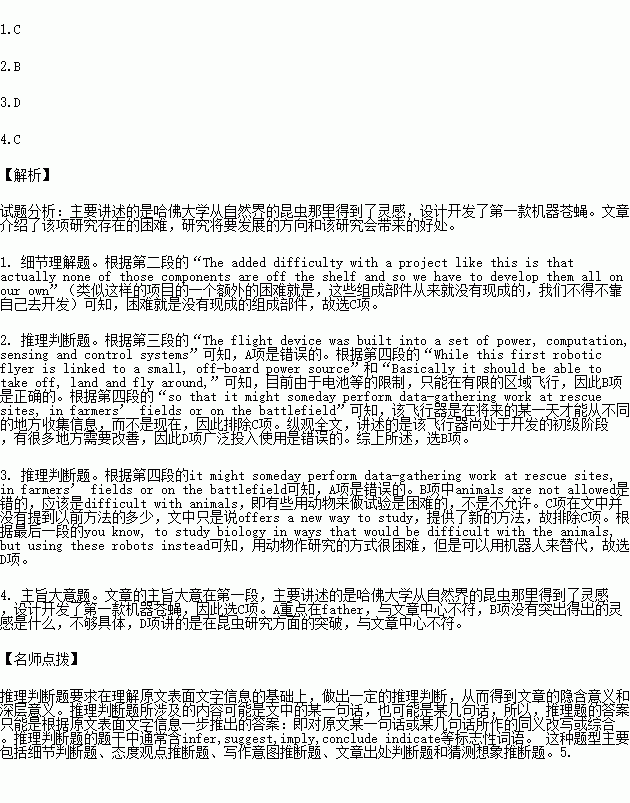题目内容
A team of engineers at Harvard University has been inspired by Nature to create the first robotic fly. The mechanical fly has become a platform for a series of new high-tech integrated systems. Designed to do what a fly does naturally, the tiny machine is the size of a fat housefly. Its mini wings allow it to stay in the air and perform controlled flight tasks.
“It’s extremely important for us to think about this as a whole system and not just the sum of a bunch of individual components (元件),” said Robert Wood, the Harvard engineering professor who has been working on the robotic fly project for over a decade. A few years ago, his team got the go-ahead to start piecing together the components. “The added difficulty with a project like this is that actually none of those components are off the shelf and so we have to develop them all on our own,” he said.
They engineered a series of systems to start and drive the robotic fly. “The seemingly simple system which just moves the wings has a number of interdependencies on the individual components, each of which individually has to perform well, but then has to be matched well to everything it’s connected to,” said Wood. The flight device was built into a set of power, computation, sensing and control systems. Wood says the success of the project proves that the flying robot with these tiny components can be built and manufactured.
While this first robotic flyer is linked to a small, off-board power source, the goal is eventually to equip it with a built-in power source, so that it might someday perform data-gathering work at rescue sites, in farmers’ fields or on the battlefield. “Basically it should be able to take off, land and fly around,” he said.
Wood says the design offers a new way to study flight mechanics and control at insect-scale. Yet, the power, sensing and computation technologies on board could have much broader applications. “You can start thinking about using them to answer open scientific questions, you know, to study biology in ways that would be difficult with the animals, but using these robots instead,” he said. “So there are a lot of technologies and open interesting scientific questions that are really what drives us on a day to day basis.”
1.The difficulty the team of engineers met with while making the robotic fly was that ________.
A. they had no model in their mind
B. they did not have sufficient time
C. they had no ready-made components
D. they could not assemble the components
2.It can be inferred from paragraphs 3 and 4 that the robotic fly ________.
A. consists of a flight device and a control system
B. can just fly in limited areas at the present time
C. can collect information from many sources
D. has been put into wide application
3.Which of the following can be learned from the passage?
A. The robotic flyer is designed to learn about insects.
B. Animals are not allowed in biological experiments.
C. There used to be few ways to study how insects fly.
D. Wood’s design can replace animals in some experiments.
4.Which of the following might be the best title of the passage?
A. Father of Robotic Fly
B. Inspiration from Engineering Science
C. Robotic Fly Imitates Real Life Insect
D. Harvard Breaks Through in Insect Study

